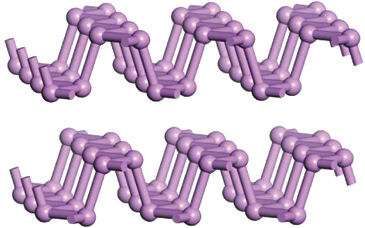Phosphorene reveals its superconductivity

A new atomically thin material similar to graphene has been proven to be a promising new superconductive material.
Black phosphorous - a layered material, somewhat similar to graphite – has generated much excitement among scientists and engineers because of its many interesting and useful electronic and optical properties.
Just as graphite is made up of millions of layers of graphene, black phosphorus consists of layers of phosphorene that can be isolated. New research now reveals phosphorene to possess properties as intriguing as graphene.
Combining graphene and other new 2-D materials such as phosphorene, which individually have excellent characteristics complementary to the extraordinary properties of graphene, has resulted in exciting scientific developments and could produce applications as yet beyond our imagination.
Now phosphorene is helping scientists to answer the question of whether materials consisting of just one layer of atoms can be superconducting. Superconductors conduct electricity with zero resistance and are always sought after due to their potential applications in sensors, energy-efficient power lines and magnets capable of generating large magnetic fields, such as those used in MRI scanners and levitating trains.
Using phosphorene, a University of Manchester team led by Professor Irina Grigorieva clearly shows that atomically thin materials can be true superconductors as long as enough electrons are pumped into the layers.
Atomically thin superconductors are desirable in miniature devices but also of much interest to scientists because they can be used to test ideas about the limits of the existence of superconductivity.
Bulk materials often become superconducting if a sufficient amount of electrons is added and they start to strongly interact with each other. Superconductivity in one atom thick two-dimensional materials was discovered only a decade ago but the findings often referred not to isolated atomically thin layers but their bulk assemblies and the evidence was so far weak and sometimes controversial.
In a report published in Nature Communications, scientists used a process called intercalation – essentially coating phosphorene layers in black phosphorus with different alkali atoms that donate their electrons to phosphorene. In each case this turned black phosphorus into a superconductor with exactly the same properties, irrespective of what kinds of atoms were used to add electrons to the layers of phosphorene.
Prof Irina Grigorieva said: "Nothing like this was known before. This new understanding is important for developing atomically thin materials towards applications in electronics and quantum technologies."
Renyan Zhang, a PhD student who led the experimental effort, said: "Phosphorene and its parent material, black phosphorus, are in many respects similar to graphene and graphite, so we expected that each electron-donating metal will produce a different superconductor, as is the case with graphene and graphite. But to our great surprise all metal donors produced exactly the same superconducting material, with identical properties."
More information: Intercalant-independent transition temperature in superconducting black phosphorus. arxiv.org/abs/1702.05017
Journal information: Nature Communications
Provided by University of Manchester



















